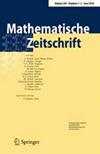戈伦斯坦法向曲面奇点的复元分类
IF 1
3区 数学
Q1 MATHEMATICS
引用次数: 0
摘要
考虑一个复正则面奇异性及其三个复元,即渡边(Watanabe)的第m个(L^2\)复元、诺勒(Knöller)的第m个复元和莫拉莱斯(Morales)的第m个对数复元。对于这些不变式中的任何一个,我们都会构造一个双分级(\mathbb {Z}[U]\ )模块,其欧拉特征就是所选的诸元。我们将这三个结果与胚芽的解析晶格同调进行比较,后者的欧拉特征是经典几何属。本文章由计算机程序翻译,如有差异,请以英文原文为准。
Categorification of the plurigenera of Gorenstein normal surface singularities
Consider a complex normal surface singularity and its three plurigenera, the m-th \(L^2\)–plurigenus of Watanabe, the m-th plurigenus of Knöller and the m-th log-plurigenus of Morales. For any of these invariants we construct a double graded \(\mathbb {Z}[U]\)–module, whose Euler characteristic is the chosen plurigenus. The three outputs are compared with the analytic lattice cohomology of the germ, whose Euler characteristic is the classical geometric genus.
求助全文
通过发布文献求助,成功后即可免费获取论文全文。
去求助
来源期刊
CiteScore
1.60
自引率
0.00%
发文量
236
审稿时长
3-6 weeks
期刊介绍:
"Mathematische Zeitschrift" is devoted to pure and applied mathematics. Reviews, problems etc. will not be published.

 求助内容:
求助内容: 应助结果提醒方式:
应助结果提醒方式:


